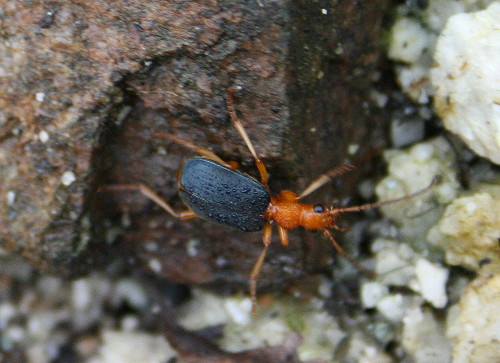Adaptation
Quinine is not just found in the Cinchona
pubescens trees. Amazingly enough quinine is
produced by a bug called the
Bombardier Beetle. The beetle has two
chemicals in its body which are called hydrogen
peroxide
 dissolved
in water and hydroquinine. If both of the chemicals
were mixed, the peroxide would oxidize the
hydroquinine. However, this does not happen. The
beetle contains an inhibitor which blocks the
oxidation from occurring. These two chemicals are
able to mix in the combustion chamber of the beetle
without any reaction occurring. When a predator
approaches, the beetle uses two enzymes called
catalase and peroxidase to produce quinine. When
the quinine is formed, it gives off a very foul
odor. The foul smell, as well as the combustion
chamber exerting enough pressure to squirt out its
contents at an amazing 500 pulses per second at 212
degrees Celsius kills the predator!
dissolved
in water and hydroquinine. If both of the chemicals
were mixed, the peroxide would oxidize the
hydroquinine. However, this does not happen. The
beetle contains an inhibitor which blocks the
oxidation from occurring. These two chemicals are
able to mix in the combustion chamber of the beetle
without any reaction occurring. When a predator
approaches, the beetle uses two enzymes called
catalase and peroxidase to produce quinine. When
the quinine is formed, it gives off a very foul
odor. The foul smell, as well as the combustion
chamber exerting enough pressure to squirt out its
contents at an amazing 500 pulses per second at 212
degrees Celsius kills the predator!
Quinine is also used in a much similar way in protecting the Cinchona pubescens. Quinine is an alkaloid which is derived from the bark of the tree. Alkaloids have a variety of effects on the metabolic functions of humans and animals. More importantly, quinine has a very bitter taste which is helpful in keeping the predators away.
An experiment conducted by John Skelhorn and
Candy Rowe from the University of Newcastle assessed
how predators are affected by the chemical defenses
of the prey. Basically, the scientists set up two
cages with
 baby chicks in each. Quinine and bitrex
are both chemicals that are bitter-tasting to
chicks. Bread crumbs were sprayed with quinine and
bitrex and also water. The quinine and bitrex
sprayed crumbs were then colored red and the water
sprayed crumbs were colored green. The findings of
the experiment concluded that the birds were not
able to distinguish between the different colored
crumbs. The rate of attack on the bread crumbs was
the same for all of the groups, but the chicks ate a
higher proportion of the green crumbs. This
information can be used to infer that quinine in
Cinchona pubescens is an adaptation used to
keep predators from attacking it. To learn
more about the details of this experiment, visit
Biology Letters.
baby chicks in each. Quinine and bitrex
are both chemicals that are bitter-tasting to
chicks. Bread crumbs were sprayed with quinine and
bitrex and also water. The quinine and bitrex
sprayed crumbs were then colored red and the water
sprayed crumbs were colored green. The findings of
the experiment concluded that the birds were not
able to distinguish between the different colored
crumbs. The rate of attack on the bread crumbs was
the same for all of the groups, but the chicks ate a
higher proportion of the green crumbs. This
information can be used to infer that quinine in
Cinchona pubescens is an adaptation used to
keep predators from attacking it. To learn
more about the details of this experiment, visit
Biology Letters.
To find out how the fever tree is able to attain its nutrition to survive, go to Nutrition.
Take me Home.